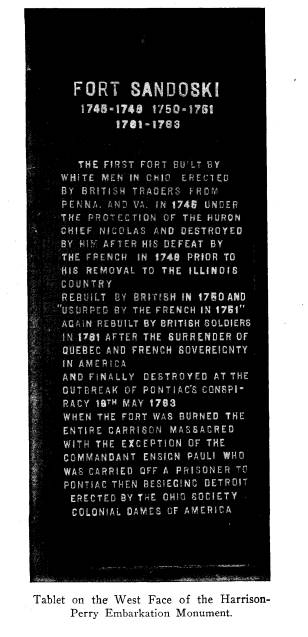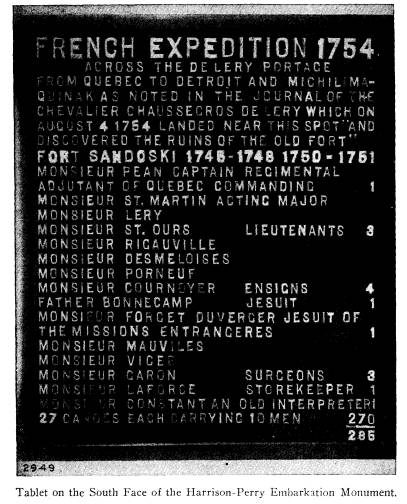Ohio History Journal
362 Ohio Arch. and Hist.
Society Publications.
The short inscription of this tablet we
are honoring today,
gives concisely historic facts which all
may read.
It does not need a very vivid
imagination to see and feel
all the labor, sacrifice, bloodshed,
aching hearts and desolate
homes which are summed up in these
facts.
We exult over the victories achieved,
and thrill with horror
over the martyrdom of Col. Crawford.
His name is on the bead-roll of fame,
and we all unite to
honor his memory, (and here it gives me
pleasure to state that
our newest chapter, in Bucyrus, is named
"Hannah Crawford,"
in memory of the brave wife of the
martyr.)
Could he speak we might hear him say:
"I have executed a
monument more lasting than brass, and
more sublime than the
regal elevation of pyramids which
neither the wasting shower,
the unavailing north wind, or an
innumerable succession of years
and the flight of seasons shall be able
to demolish."-(Smart's
Horace.)
In the name of the Ohio Daughters of the
American Revo-
lution, I present this tablet to mark
the northern terminal of the
old Indian water way and land trail,
later known as the
"Harrison Trail."
ADDRESS OF MRS. JOHN T. MACK.
The Daughters of the War of 1812 esteem it a great honor
to have erected this, their first tablet
in the State of Ohio on so
historic a spot, and especially so,
because it commemorates so
much history in the war period this
organization stands for.
We have gathered here today to
commemorate scenes in the
making of our nation which transpired
almost one hundred
years ago. Here the red man came from
the northland on his
way to the beautiful Ohio country.
Again, we read of the trap-
per and a little later, of the history
of old Fort Sandoski, and
of the terrible scenes enacted there at
the time of Pontiac's con-
spiracy. During the war of 1812,
Commodore Perry and Gen-
eral William Henry Harrison met in
council not far from this
place. Commodore Perry requested Gen.
Harrison to give him
troops to help man his ships. Thirty-six
men responded, and 45
|
Old Fort Sandoski and the De Lery Portage. 363 |
|
|
364 Ohio
Arch. and Hist. Society Publications.
years ofter the battle of Lake Erie,
William Blair, of Lexing-
ton, Richland county, one of those 36
men who had volunteered,
visited Put-in-Bay, and attended the
45th anniversary cele-
bration of the battle of Lake Erie. He
exhibited a rich and
massive silver medal, bearing the
impress of Perry, with approp-
riate inscription, which had been
presented to him with the
thanks of the commonwealth of
Pennsylvania, of which state
he was then a citizen, in testimony of
his bravery in that memor-
able battle. After the battle of Lake
Erie, General Harrison be-
gan to concentrate his forces at the
mouth of the Portage river
here. Governor Shelbey was on his march,
and joined him with
4,000 volunteers from Kentucky. General
McArthur had ar-
rived at Fort Meigs, General Cass had
reached Upper Sandoski,
and Colonel Hill with a regiment of
Pennsylvania volunteers
was on the march from Erie. About 7,000
men were advancing
for the invasion of Canada. On September
17, Governor Shel-
bey with his 4,000 mounted troops
arrived at the Portage. Gen-
eral Harrison thought it best that they
serve as infantry in the
invasion, and in order to secure their
horses against escape, it
was necessary to build a brush and log
fence across the penin-
sula, from Sandoski Bay to the Portage
river. This provided
the horses a luxurious pasture. The
number of horses left here
on the peninsula is estimated to have
been about 5,000. On the
20th of September, Gen. McArthur's
brigade from Fort Meigs,
joined the main body here, after a
fatiguing march of 36 miles
clown the Lake Shore by way of
Brownstown. Col. Johnson's
regiment had orders to approach Detroit
by land, direct from
Fort Meigs, while such of Col. Hill's
detached militia, as chose
not to cross into Canada were ordered to
guard the British
prisoners taken by Commodore Perry from
the Portage to Chil-
licothe. The different posts on the
American side were left in
charge of Ohio militia, and about 500 of
the Kentucky volun-
teers remained to guard the horses and
stores. On the 21st of
September, at the dawn of the day, the
embarkation from this
immediate shore commenced. For want of
sufficient boats, not
more than one-third could embark at one
time, and it was neces-
sary for the boats to return several
times before all the troops
could be transported to Put-in-Bay,
while Perry's fleet was busi-
|
Old Fort Sandoski and the De Lery Portage. 365
ly engaged in conveying the baggage of the army. On the 22d of September, the whole army had reached the island and was encamped on the margin of the bay. The Lawrence and six |
|
|
|
prize ships captured from the enemy lay at anchor in the center of the bay, in full view. Here they remained until the 25th of September when they again embarked, some in small boats, and |
366 Ohio Arch. and Hist. Society Publications.
some on board the fleet to take their
second position nearer
Canada. They arrived a little before
sunset that day at East
Sister Island, while General Harrison
and Commodore Perry
in the Ariel, made a reconnoissance of
the enemy's coast. It
was not until the morning of the 27th,
that they began this last
journey across the lake. One account
says the day was fine and
a propitious breeze made their passage a
pleasing pastime. It
was a sublime and inspiring spectacle to
behold sixteen ships
of war and a hundred boats filled with
men borne rapidly and
majestically to the long sought shores
of the enemy, and thus
they sailed until 4 p. m., when they
landed four miles below
Malden. From this point, they marched to
Detroit, and then
on to victory at the battle of the
Thames. The battle of Lake
Erie was the first encounter of our
infant navy, in fleet and
squadron, the Guerriere, the Java, and
Macedonia had sur-
rendered in combat with single ships,
but it was on the waters
of our fair Lake Erie, that the British
nation was taught that
we could conquer them in squadron array.
The battle of Lake
Erie opened to Gen. Harrison and his
army the gate-way to
Malden, and enabled him to capture the
only army that was
taken during the war of 1812. More than
this, it restored to us
Detroit, gave our young nation once
more, free navigation of the
Great Lakes, and shielded the frontier
for 300 miles from the
assaults of the torch of a British and
savage foe. Mr. Chairman,
the National Society, the United States
Daughters of the War
of 1812, State of Ohio, presents with
great pleasure, for safe-
keeping, this tablet with the patriotic
hope that those who pass
by in future years, will stop and read
of the brave men and their
deeds recorded hereon, and cherish anew
love of liberty and
free government which made this a
nation, and has always
kept it such. This tablet marks the
nothern terminus of Ohio's
famous Harrison trail-a historic spot
indeed in the history of
this republic.
PROF. G. F. WRIGHT'S ADDRESS.
Ladies and Gentlemen, we are standing
upon one of the
most interesting spots connected with
American history. From
the middle of the eighteenth century to
the close of the War of

